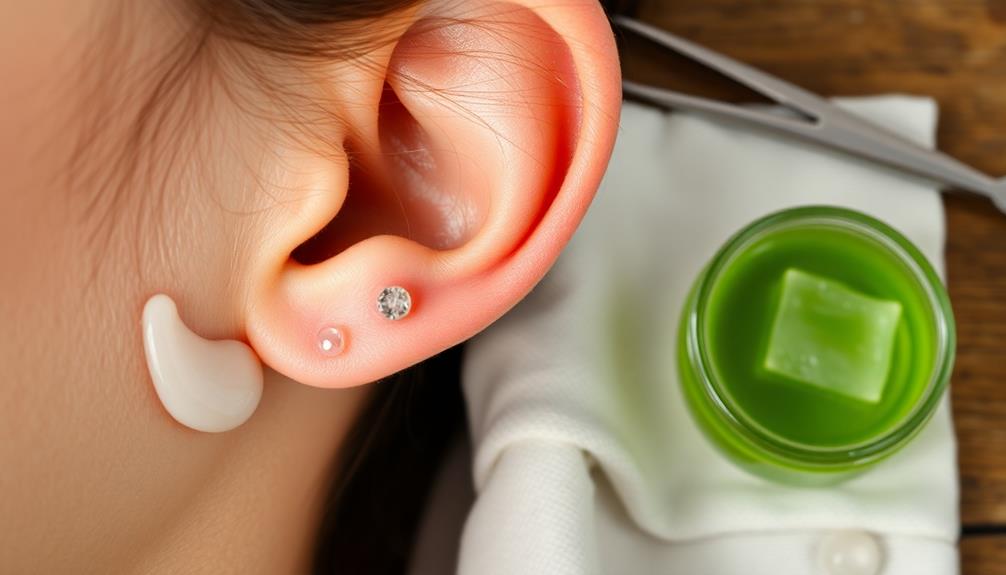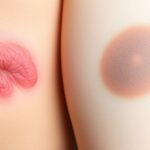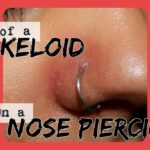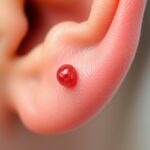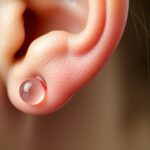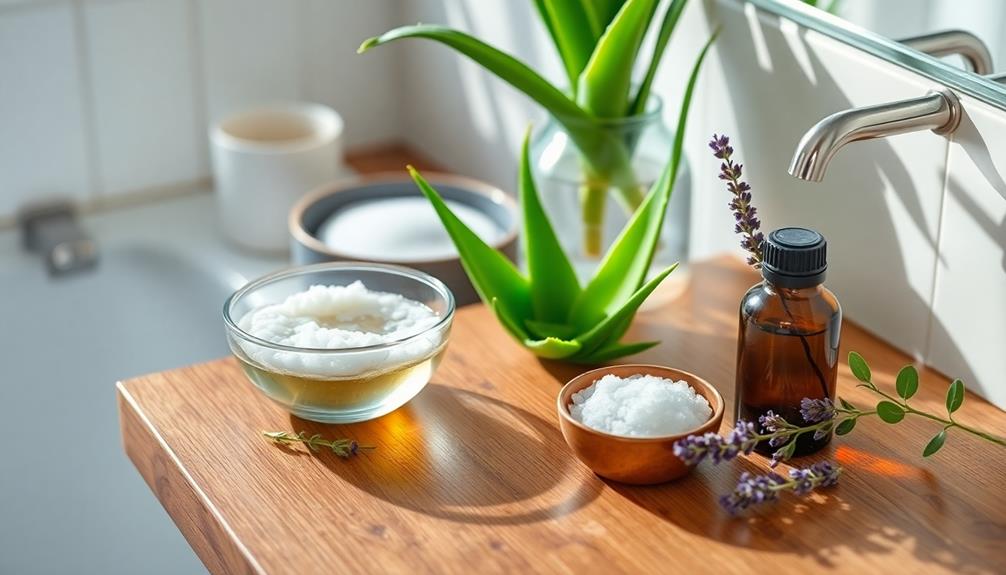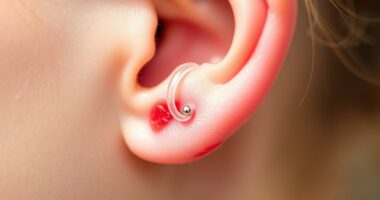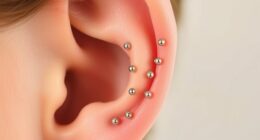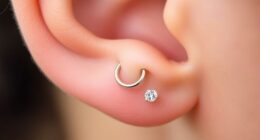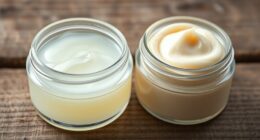To deal with piercing bumps and keloids, start by understanding their differences. Piercing bumps often heal on their own with warm compresses and gentle care. Use hypoallergenic jewelry and clean your piercings regularly to prevent irritation. If you notice keloids, which are thicker and can grow beyond the original site, it's essential to consult a healthcare provider for treatment options like corticosteroid injections or surgical removal. Always monitor your piercings for changes and keep your skin healthy. Stick around to uncover more tips and insights on effective management!
Key Takeaways
- Use warm compresses and topical antibiotics to reduce inflammation and promote healing of piercing bumps.
- Monitor for signs of thickening at the piercing site to catch potential keloids early.
- Opt for hypoallergenic jewelry made from titanium or gold to minimize irritation and prevent bumps.
- Consult a healthcare professional for persistent bumps or keloids to explore treatment options like corticosteroid injections or surgical removal.
- Maintain a clean piercing routine with fragrance-free antimicrobial soap to prevent infection and support healing.
Understanding Piercing Bumps and Keloids
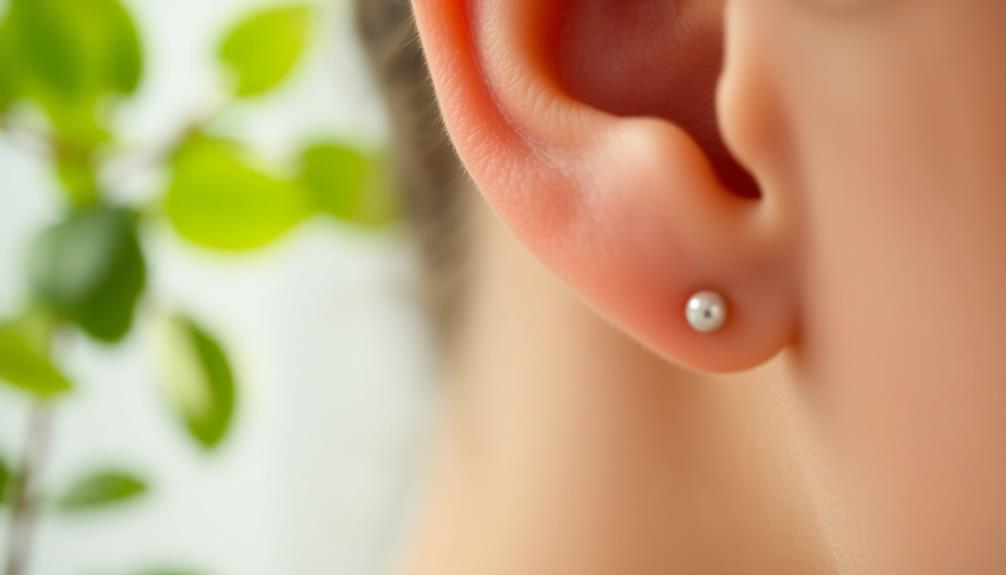
When you get a piercing, it's not uncommon to encounter issues like piercing bumps or keloids.
Piercing bumps are small, raised areas at the site that can appear reddish in color. They typically resolve naturally within a few weeks as part of the healing process.
In contrast, keloids are thick, raised scars that extend beyond the original injury and can remain permanent without treatment.
You may notice symptoms of piercing bumps such as tenderness, redness, and sometimes even pus. Keloids, however, can develop later on, often taking 3 to 12 months, and may exhibit itchiness and discomfort.
The risk of developing keloids is higher if you have a family history, while piercing bumps can arise from irritation, allergic reactions, or infections, especially in cartilage piercings.
Proper aftercare is essential in preventing both piercing bumps and keloids. Using hypoallergenic jewelry and avoiding trauma to the piercing site can greatly improve your chances of a smooth healing process.
If you do develop keloids, treatment options may include corticosteroid injections or surgical removal, so be proactive in managing your piercings.
Symptoms and Differentiation
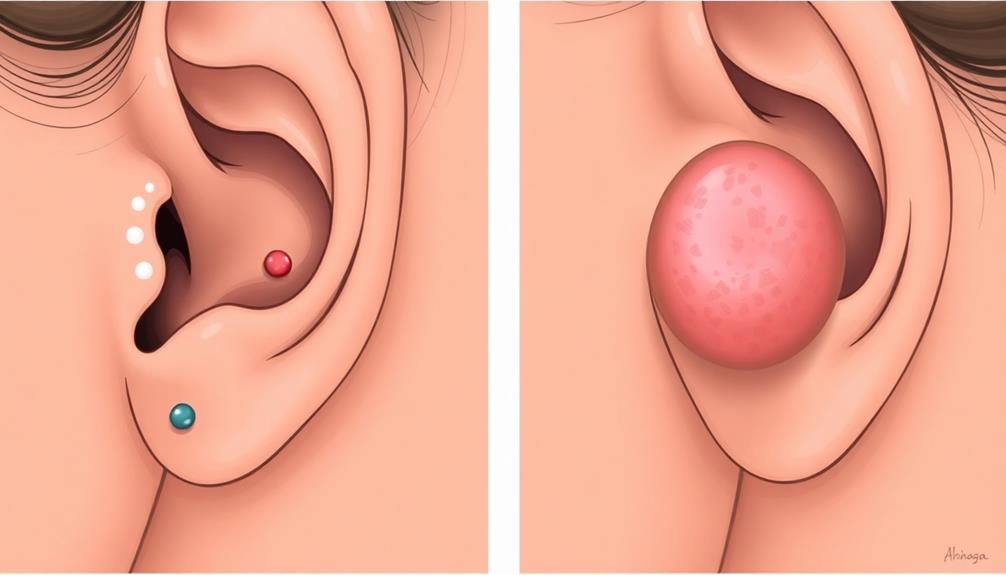
Understanding the symptoms of piercing bumps and keloids is essential for effective management of your piercings. Piercing bumps typically appear as small, localized raised areas at the piercing site. You might notice redness, tenderness, and even some swelling, often accompanied by pus. Fortunately, these symptoms usually resolve within a few weeks as part of the natural healing process.
In contrast, keloids are thicker, raised scars that extend beyond the original injury site. They may appear shiny, darker, and can develop over a longer period—anywhere from 3 to 12 months after the injury.
To differentiate between the two, consider the size, texture, and growth patterns. Piercing bumps fluctuate in size and heal without intervention, while keloids gradually grow and can cause itchiness or discomfort. Keloids may require medical intervention for management, especially since they've a higher recurrence risk after removal.
Consulting a healthcare professional for visual inspection, combined with your medical history and family predisposition, is vital for accurate differentiation. Recognizing these symptoms will help you take the right steps towards caring for your piercings.
Treatment Options for Bumps and Keloids
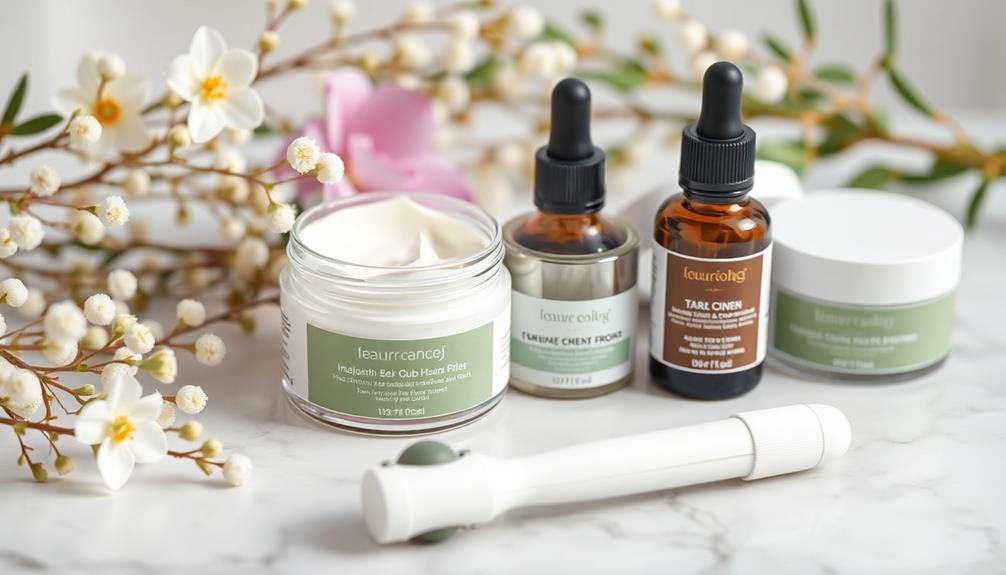
Dealing with piercing bumps and keloids requires targeted treatment options to effectively address the issues at hand.
For piercing bumps, you can start with warm compresses to reduce inflammation and promote healing. Topical antibiotics or steroid creams may also help alleviate redness and irritation. Home remedies like tea tree oil or silicone sheets can provide additional relief, but keep an eye out for any signs of irritation or worsening symptoms.
When it comes to keloids, the treatment options become a bit more complex. Corticosteroid injections are often effective in reducing the size and discomfort of keloids. In some cases, surgical removal may be necessary, especially if the keloid is persistent.
Compression therapy has shown promise, particularly for keloids on earlobes, using custom-made devices to help minimize size and discomfort over time.
It's essential to consult a healthcare provider if you're dealing with persistent bumps or keloids. They can offer tailored treatment plans and monitor any complications, ensuring you receive the appropriate care for your specific situation.
Prevention Strategies for Piercings
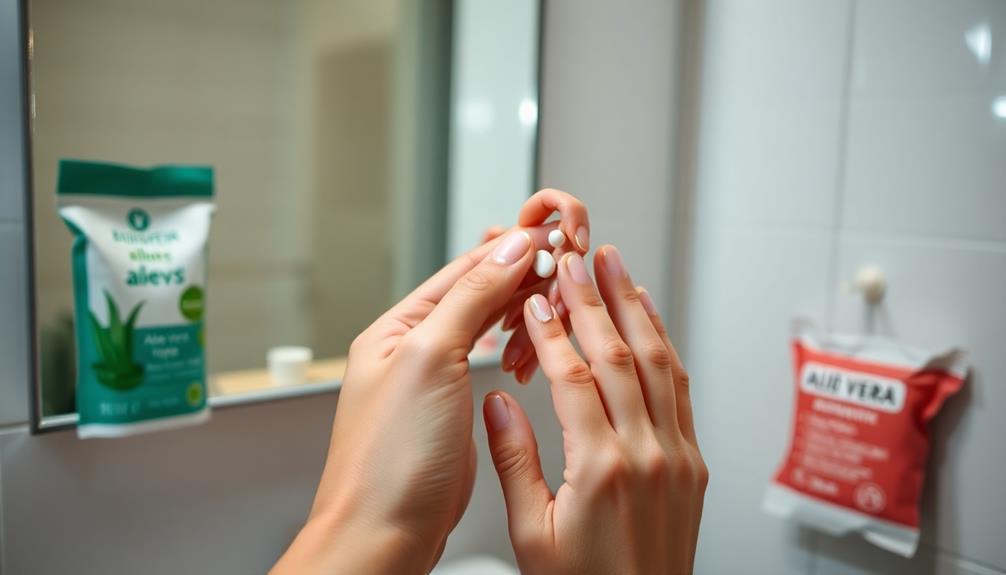
Taking proactive steps can notably reduce the risk of developing piercing bumps and keloids. If you have a family history of keloids, it's wise to reflect on avoiding new piercings, especially in sensitive areas like your ears.
When you do decide to get a piercing, opt for hypoallergenic jewelry made from materials like titanium, stainless steel, or 18-24 karat gold. These materials help minimize irritation and allergic reactions. Additionally, maintaining a healthy diet can support overall skin health, which is beneficial during the healing process; think about incorporating foods rich in vitamins A, C, and K for added benefits nutritional support for dogs.
Proper aftercare is essential. Clean the piercing with a fragrance-free antimicrobial soap 2-3 times daily, and steer clear of irritants like alcohol and hydrogen peroxide, as they can complicate healing.
Keep an eye on the piercing site for any signs of thickening or abnormal growth; early intervention is key to preventing keloid formation.
Additionally, wearing pressure earrings for 12-20 hours daily during the initial healing phase can greatly reduce the risk of keloids, especially if you're prone to them.
Risk Factors for Keloid Development
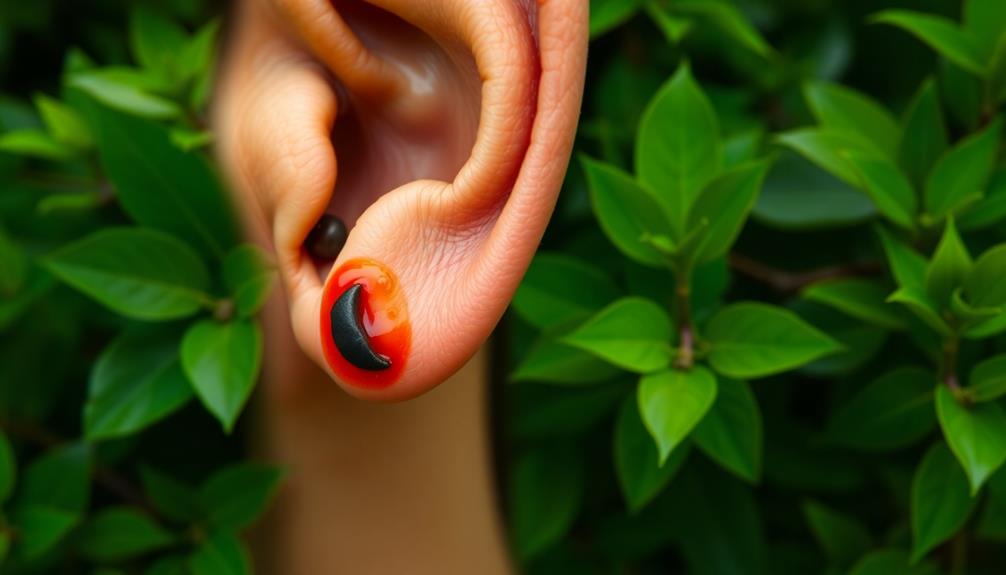
When it comes to keloid development, your family history plays a significant role, especially if someone in your family has had issues with keloids.
Additionally, if you have darker skin, you're at a higher risk, and it's important to evaluate the age at which you get piercings.
Understanding these risk factors can help you make informed decisions about your piercings and minimize potential complications.
Family History Impact
Family history greatly influences the likelihood of developing keloids, making it vital to understand your genetic background before getting piercings. If you have relatives who've experienced keloids, your risk of developing them increases considerably.
Studies show that keloids can form in 5-15% of all wounds, and knowing your family's skin history can help you gauge your own risk.
Individuals with a genetic predisposition, particularly those with a family history of keloids, should approach ear piercings with caution. It's generally recommended to get these piercings before age 11 or, if possible, to avoid them altogether.
This preventive measure can minimize your risk of keloid formation.
Additionally, if you're dark-pigmented, be aware that you statistically have a higher chance of developing keloids compared to lighter-skinned individuals.
This highlights the significance of genetic factors in keloid susceptibility.
Remember, you may not discover your family history until after a piercing has occurred, so it's vital to do your research beforehand.
Taking these factors into account can help you make informed decisions regarding body modifications.
Skin Tone Considerations
Many individuals with darker-pigmented skin face a heightened risk of developing keloids, making it essential to contemplate skin tone when thinking about piercings. Keloids can arise from various skin injuries, including those at the piercing site.
If you have darker skin, your risk increases due to higher collagen production, which is a fundamental factor in keloid formation. Genetic factors also play a significant role, particularly if you have a family history of keloids.
Studies show that keloids occur in 5-15% of all wounds, but this percentage is particularly higher for individuals with darker-pigmented skin. This means that if you're considering a piercing, you should be especially vigilant.
Early intervention is vital. After any skin injury, including a piercing, monitor the area closely for signs of thickening or changes in texture. If you notice anything unusual, seek advice from a healthcare professional promptly.
Being proactive can help you manage the risk of keloid development and keep your skin healthy. Remember, understanding these risk factors can empower you to make informed choices about your body and skin care.
Piercing Age Recommendations
Understanding your unique risk factors is important, especially regarding piercing age recommendations. If you have a family history of keloids, it's wise to reflect on getting your ear piercings before age 11, or perhaps even rethink piercing altogether. Keloids can develop in 5-15% of all wounds, including piercings, so evaluating your medical background is essential before making any decisions.
Darker-pigmented individuals face a higher likelihood of keloid development, which should greatly influence your piercing decisions. The risk of keloid formation increases if you wait until after age 11 to get a piercing, as your skin may become more prone to excessive collagen production at that stage.
Once you do get a piercing, monitoring signs of thickening at the site immediately after is crucial. Early intervention can help prevent the formation of keloids. Stay vigilant and consult a professional if you notice any unusual changes.
Making informed choices about the timing of your ear piercings can considerably decrease your keloid risk and lead to a more successful healing process.
Home Remedies and Aftercare Tips
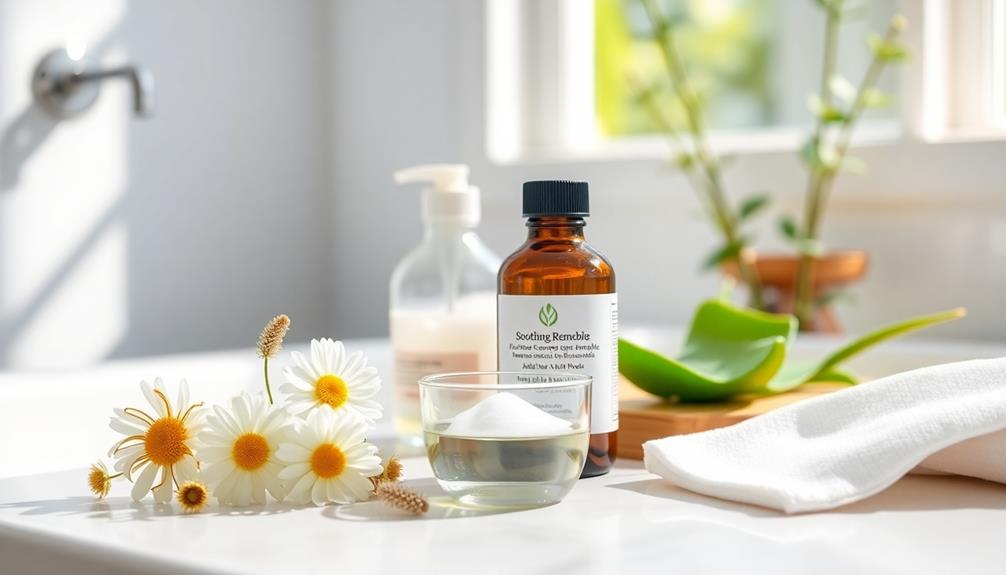
Regularly using home remedies and proper aftercare techniques can greatly improve your chances of healing piercing bumps and keloids.
Start by creating warm saline compresses; simply dissolve ¼ teaspoon of sea salt in 8 ounces of warm water. Apply this compress to the affected area to reduce swelling and promote healing.
Incorporate natural oils like jojoba or rose oil into your routine. These oils help with moisture retention and support collagen production, which is essential for healing.
Avoid irritants such as alcohol and hydrogen peroxide, as they can worsen irritation and delay recovery.
Consistent cleaning is key. Use a fragrance-free antimicrobial soap to clean your piercing area 2-3 times daily. This minimizes infection risks and aids in proper healing.
If you're prone to keloids, consider using pressure earrings at the first sign of thickening skin. Wearing them for 12-20 hours daily for 4-6 months can help prevent keloid formation.
Frequently Asked Questions
Should You Take Your Piercing Out if You Get a Keloid?
You shouldn't take your piercing out if you get a keloid. Removing it can worsen the situation. Instead, keep it in place to explore treatment options and consult a healthcare professional for guidance.
How to Tell if It's a Keloid or Piercing Bump?
To tell if it's a keloid or a piercing bump, check the size and texture. Keloids extend beyond the piercing site and feel firm, while bumps stay localized and might be red or tender.
How to Heal Piercing Bumps Overnight?
To heal piercing bumps overnight, apply a warm saline compress, gently massage with diluted tea tree oil, and use a topical antibiotic. Avoid friction and sleep on the opposite side to promote faster healing.
Do Bumps Go Away on Piercings?
Just like clouds part after a storm, bumps on piercings can fade with proper care. You'll often find they disappear within weeks if you maintain hygiene and avoid irritation. Stay patient, and healing will come!
Conclusion
To sum up, dealing with piercing bumps and keloids can be frustrating, but knowing how to manage them makes a difference. Did you know that about 10% of people are prone to developing keloids? By understanding the symptoms, exploring treatment options, and following prevention strategies, you can minimize your risk and keep your piercings looking their best. Always remember to care for your piercings properly to avoid complications and enjoy your unique style without worries!

